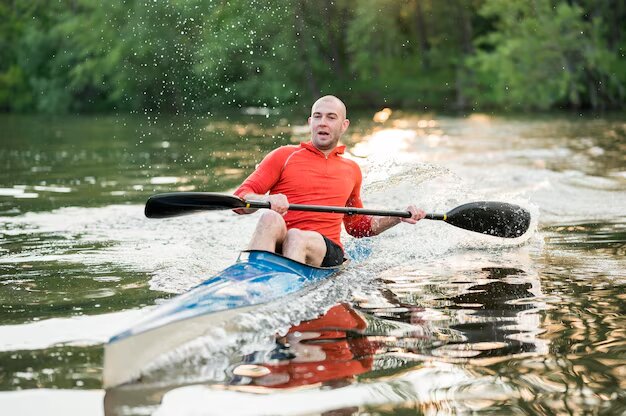
Tessa Young
Kayak Expert

John Smith
Expert Reviewed |Kayak Expert
Update
In this guide, we’ll dive into the 10 common kayaking mistakes and show you how to steer clear of them. From choosing the right kayak to mastering proper paddling techniques, we’ve got you covered. So, buckle up (or should we say, strap on your life jacket?) as we explore these essential tips that will help you become a more confident, safe, and environmentally conscious kayaker.

On This Page
- 1 Choosing the Wrong Kayak
- 2 Skipping Safety Precautions
- 3 Improper Paddling Technique
- 4 Neglecting Essential Gear
- 5 Overestimating Your Abilities
- 6 Poor Trip Planning
- 7 Ignoring Proper Kayak Maintenance
- 8 Disregarding Environmental Impact
- 9 Inadequate Clothing Choices
- 10 Failing to Learn and Practice Rescue Techniques
- 11 Conclusion:
- 12 FAQS:
- 13 About Author
Choosing the Wrong Kayak
Now that we’ve introduced the topic of common kayaking mistakes, let’s dive into one of the most crucial aspects: selecting the right kayak. Choosing the wrong kayak can significantly impact your kayaking experience and even compromise your safety on the water.
Ignoring skill level
One of the most common kayaking mistakes is disregarding your skill level when selecting a kayak. Beginners should opt for wider, more stable kayaks, while experienced paddlers can handle narrower, faster models.
Overlooking kayak type and purpose
Different kayaks are designed for specific purposes. Here’s a quick comparison:
Kayak Type | Best For | Features |
Recreational | Calm waters, beginners | Stable, easy to maneuver |
Touring | Long trips, open water | Fast, tracks well |
Whitewater | Rapids, technical water | Highly maneuverable, durable |
Fishing | Angling enthusiasts | Stable, storage space |
Neglecting comfort and fit
A comfortable kayak enhances your paddling experience. Consider these factors: Cockpit size
- Seat adjustability
- Leg room
- Weight capacity
Remember, the right kayak should feel like an extension of your body. Take time to test different models and consult with experienced paddlers or outfitters to find the perfect fit for your needs and skill level.
Skipping Safety Precautions
Now that we’ve discussed choosing the right kayak, let’s dive into a crucial aspect of kayaking that many beginners overlook: safety precautions. Ignoring these can turn a fun adventure into a dangerous situation.
A. Forgetting to wear a life jacket
Wearing a life jacket is non-negotiable, regardless of your swimming ability. It can be the difference between life and death in unexpected situations.
B. Neglecting to check weather conditions
Always check the forecast before heading out. Sudden changes in weather can create hazardous conditions on the water.
C. Failing to inform others of your plans
Before embarking on your kayaking trip, always let someone know your plans, including your route and expected return time.
D. Ignoring local regulations and guidelines
Each waterway may have specific rules and guidelines. Familiarize yourself with these to ensure a safe and legal kayaking experience.
Safety Precaution | Importance | Consequence of Skipping |
Wearing a life jacket | Critical | Risk of drowning |
Checking weather | High | Caught in dangerous conditions |
Informing others | Important | Delayed rescue if needed |
Following regulations | Necessary | Legal issues, fines |
Remember, these safety precautions are among the most common kayaking mistakes to avoid:
- Always wear a properly fitted life jacket
- Check weather forecasts and water conditions
- Inform a responsible person about your trip details
- Research and follow local kayaking regulations
By adhering to these safety measures, you’ll significantly reduce risks and enhance your kayaking experience. Next, we’ll explore another critical aspect of kayaking: proper paddling technique.
Improper Paddling Technique
Now that we’ve covered safety precautions, let’s dive into one of the most crucial aspects of kayaking: proper paddling technique. Many beginners make the mistake of using incorrect form, which can lead to fatigue, discomfort, and even injury.
A. Using arms instead of core muscles
One of the most common kayaking mistakes is relying too heavily on arm strength for paddling. This approach quickly leads to exhaustion and reduces your overall efficiency on the water. Instead, focus on engaging your core muscles to power your strokes. Here’s a comparison of arm-centric vs. core-centric paddling:
Arm-Centric Paddling | Core-Centric Paddling |
Quick fatigue | Increased endurance |
Limited power | More powerful strokes |
Risk of shoulder strain | Reduced injury risk |
Inefficient energy use | Better energy conservation |
A. Holding the paddle incorrectly
Proper paddle grip is essential for efficient kayaking. Many novices grip the paddle too tightly or position their hands incorrectly. To avoid this mistake:
- Hold the paddle with a relaxed grip
- Position your hands shoulder-width apart
- Ensure the concave side of the blade faces you
B. Failing to maintain proper posture
Poor posture can lead to back pain and reduced paddling efficiency. To maintain proper form:
- Sit up straight with your back against the seat
- Keep your feet pressed against the foot pegs
- Engage your core muscles throughout your paddling motion
By avoiding these common paddling technique mistakes, you’ll enjoy a more comfortable and efficient kayaking experience. Next, we’ll explore the essential gear you shouldn’t neglect when heading out on the water.
Neglecting Essential Gear
When embarking on a kayaking adventure, it’s crucial to pack the right gear. Many novice kayakers make the mistake of overlooking essential items that can make or break their experience on the water. Let’s explore some commonly neglected gear and why they’re vital for a safe and enjoyable kayaking trip.
A. Forgetting Sun Protection
Sun protection is often underestimated by kayakers, but it’s a critical component of your gear. Being out on the water exposes you to intense sunlight and reflections, increasing your risk of sunburn and heat- related illnesses.
Essential sun protection gear:
- Broad-spectrum sunscreen (SPF 30+)
- UV-protective clothing
- Wide-brimmed hat
- Polarized sunglasses
B. Overlooking Hydration Needs
Staying hydrated is crucial during any physical activity, especially when kayaking. The combination of sun exposure and physical exertion can lead to rapid dehydration if you’re not prepared.
Hydration Essentials | Benefits |
Water bottle or hydration pack | Easy access to water |
Electrolyte tablets | Replenish lost minerals |
Insulated container | Keep water cool |
C. Skipping on Dry Bags for Valuables
Many kayakers underestimate the importance of keeping their belongings dry. A good dry bag is essential for protecting electronics, spare clothes, and other items that shouldn’t get wet.
D. Ignoring the Importance of a Bilge Pump
A bilge pump is a crucial safety tool that many beginners overlook. It helps remove water from your kayak, which is essential in case of capsizing or taking on water in rough conditions.
Now that we’ve covered these essential gear items, let’s move on to discuss the importance of not overestimating your abilities when kayaking.
Overestimating Your Abilities
One of the most common kayaking mistakes is overestimating your abilities, which can lead to dangerous situations on the water. Let’s explore three key aspects of this issue:
A. Attempting challenging water conditions too soon
Many novice kayakers make the mistake of tackling difficult water conditions before they’re ready. This can include:
- Attempting rapids beyond their skill level
- Paddling in strong currents or tidal areas
- Venturing into open water without proper experience
To avoid this mistake, gradually progress through different water conditions as you gain experience and confidence.
B. Paddling beyond your physical limits
It’s crucial to understand your physical capabilities and limitations when kayaking. Consider the following factors:
- Distance you can comfortably paddle
- Duration of time you can spend on the water
- Your ability to handle different weather conditions
Physical Aspect | Beginner | Intermediate | Advanced |
Paddling Distance | 1-3 miles | 3-10 miles | 10+ miles |
Time on Water | 1-2 hours | 2-5 hours | 5+ hours |
Weather Tolerance | Calm, sunny | Light wind, overcast | Moderate wind, light rain |
C. Ignoring fatigue and exhaustion
Recognizing and responding to signs of fatigue is crucial for safe kayaking. Watch out for:
- Decreased paddling efficiency
- Difficulty maintaining proper form
- Mental fog or slow decision-making
Take regular breaks, stay hydrated, and don’t hesitate to cut your trip short if you’re feeling overly tired. Remember, it’s always better to err on the side of caution when it comes to water safety.
Now that we’ve covered the dangers of overestimating your abilities, let’s explore another common mistake: poor trip planning.
Poor Trip Planning
Poor trip planning can turn an exciting kayaking adventure into a dangerous and stressful experience. To ensure a safe and enjoyable outing, consider the following aspects of trip planning:
A. Failing to research the route
Thorough research is crucial for a successful kayaking trip. Before setting out, gather information about:
- Water conditions
- Access points
- Potential obstacles
- Local regulations
Research Item | Why It's Important |
Water conditions | Affects paddling difficulty |
Access points | Ensures entry and exit options |
Potential obstacles | Helps avoid dangerous situations |
Local regulations | Keeps you compliant with laws |
B. Underestimating travel time
Kayakers often underestimate the time needed for their journey. Consider factors such as:
- Paddling speed
- Weather conditions
- Rest breaks
- Potential delays
C. Not accounting for tides and currents
Tides and currents can significantly impact your kayaking experience. Failure to account for these factors may result in:
- Increased physical exertion
- Difficulty navigating
- Getting stranded
D. Overlooking potential hazards
Be aware of potential dangers along your route, including:
- Submerged rocks
- Low-hanging branches
- Rapids or waterfalls
- Busy boat traffic
By addressing these aspects of trip planning, you’ll be better prepared for a safe and enjoyable kayaking experience. Remember, proper planning is one of the most important steps in avoiding common kayaking mistakes.
Ignoring Proper Kayak Maintenance
As we delve into the importance of proper kayak maintenance, it’s crucial to understand that neglecting this aspect can lead to significant problems on your next adventure. Let’s explore three key areas where kayakers often fall short in maintaining their vessels.
Failing to inspect the kayak before use
Regular inspections are vital for ensuring your kayak’s safety and performance. Here’s a quick checklist to follow:
- Check for cracks or damage on the hull
- Inspect seams and joints for signs of wear
- Examine the cockpit rim for any deformities
- Test all hatches and compartments for proper sealing
Neglecting to clean the kayak after trips
Cleaning your kayak after each use is essential for its longevity. Follow these steps:
- Rinse with fresh water to remove salt, sand, and debris
- Use a mild soap to clean stubborn dirt
- Dry thoroughly to prevent mold and mildew growth
- Apply a UV-resistant protectant to plastic kayaks
Improper storage techniques
Proper storage is crucial for maintaining your kayak’s shape and integrity. Consider the following methods:
Storage Method | Pros | Cons |
Wall-mounted racks | Space-saving, easy access | Requires sturdy wall |
Freestanding racks | Versatile, portable | Takes up floor space |
Suspension system | Protects hull shape | Ceiling height dependent |
Remember, storing your kayak on its side or upside down helps prevent hull deformation. With these maintenance practices in mind, you’ll be better prepared to tackle the next crucial aspect of kayaking safety.
Disregarding Environmental Impact
As responsible kayakers, it’s crucial to understand the impact we have on the environments we explore. Disregarding environmental impact is a common mistake that can have severe consequences for ecosystems and wildlife. Let’s explore three key areas where kayakers often fall short:
A. Leaving trash behind
One of the most damaging mistakes kayakers make is leaving trash behind. This not only ruins the natural beauty of waterways but also poses serious threats to wildlife. Here’s a breakdown of common trash items and their environmental impact:
Trash Item | Environmental Impact | Decomposition Time |
Plastic bottles | Harm marine life, pollute water | 450+ years |
Food wrappers | Ingested by animals, cause suffocation | 20-30 years |
Fishing line | Entangles wildlife, causes injuries | 600 years |
Always pack out what you pack in, and consider bringing an extra bag to collect any litter you find during your trip.
B. Disturbing wildlife
Kayaking offers unique opportunities to observe wildlife, but it’s essential to maintain a respectful distance. Some ways to avoid disturbing wildlife include:
- Observing from afar using binoculars
- Avoiding loud noises or sudden movements
- Never feeding wild animals
- Steering clear of nesting areas and breeding grounds
C. Damaging shorelines and vegetation
Improper kayak handling and careless behavior can harm delicate shorelines and aquatic vegetation. To minimize your impact:
- Use designated launch and landing areas
- Avoid dragging your kayak across vegetation
- Stay in deeper water to prevent stirring up sediment
- Don’t remove plants or disturb natural habitats
By being mindful of these environmental considerations, we can help preserve the natural beauty of our waterways for future generations of kayakers to enjoy. Next, we’ll explore another common mistake that can significantly impact your kayaking experience: inadequate clothing choices.
Inadequate Clothing Choices
When it comes to kayaking, your clothing choices can make or break your experience. Many novice kayakers underestimate the importance of proper attire, leading to discomfort and potential safety risks. Let’s explore three crucial aspects of kayaking clothing that you should never overlook.
A. Wearing cotton instead of quick-dry materials
One of the biggest mistakes kayakers make is wearing cotton clothing. While cotton may be comfortable on land, it’s a poor choice for water activities. Here’s why:
Cotton | Quick-dry materials |
Absorbs water | Repels water |
Stays wet for long periods | Dries rapidly |
Becomes heavy when wet | Remains lightweight |
Loses insulating properties | Retains warmth |
Opt for synthetic materials like polyester or nylon, which wick moisture away from your skin and dry quickly, keeping you comfortable throughout your kayaking adventure.
B. Forgetting layers for temperature changes
Kayaking often involves spending extended periods on the water, where temperatures can fluctuate significantly. Failing to dress in layers can leave you either too hot or too cold. Consider the following layering system:
- Base layer: moisture-wicking material
- Insulating layer: fleece or wool for warmth
- Outer layer: waterproof and breathable jacket
This approach allows you to adjust your clothing as needed, ensuring comfort in various conditions.
C. Neglecting appropriate footwear
Your choice of footwear is crucial for both comfort and safety while kayaking. Many beginners make the mistake of wearing regular sneakers or going barefoot. Instead, consider:
- Water shoes with good grip
- Neoprene booties for colder conditions
- Sandals with heel straps for warmer weather
Proper footwear protects your feet from sharp objects, provides traction on slippery surfaces, and keeps your feet warm in cold water.
Now that you understand the importance of proper clothing choices, let’s move on to another critical aspect of kayaking safety: learning and practicing rescue techniques.
Failing to Learn and Practice Rescue Techniques
Now that we’ve covered various kayaking mistakes, let’s focus on a critical aspect often overlooked by beginners and even some experienced paddlers: rescue techniques.
Skipping self-rescue training
Self-rescue skills are essential for every kayaker. Without them, you’re putting yourself at unnecessary risk. Here’s why self-rescue training is crucial:
- Builds confidence in handling emergencies
- Increases your chances of survival in difficult situations
- Allows you to enjoy kayaking with greater peace of mind
Ignoring the importance of assisted rescues
While self-rescue is vital, knowing how to assist others is equally important. Assisted rescues can be life- saving in group situations. Consider the following:
Assisted Rescue Technique | When to Use |
T-rescue | For capsized kayaks |
Eskimo rescue | For rolled kayaks |
Towing | For exhausted paddlers |
Neglecting to practice regularly
Like any skill, rescue techniques require regular practice to maintain proficiency. Here are some tips for incorporating rescue practice into your routine:
- Schedule monthly practice sessions
- Simulate various emergency scenarios
- Practice in different water conditions
- Involve your kayaking partners in drills
Remember, rescue techniques are not just for emergencies. They’re an integral part of becoming a well- rounded and responsible kayaker. By mastering these skills, you’ll not only ensure your safety but also contribute to the overall safety of the kayaking community.
Conclusion:
Kayaking can be an exhilarating and rewarding experience, but it’s crucial to avoid common pitfalls that can compromise your safety and enjoyment. By steering clear of these ten mistakes, you’ll be well on your way to becoming a more skilled and responsible kayaker. From selecting the right kayak and gear to mastering proper paddling techniques and safety procedures, every aspect of your kayaking journey deserves careful attention.
Remember, kayaking is not just about personal enjoyment; it’s also about respecting the environment and being prepared for unexpected situations. Take the time to plan your trips, maintain your equipment, and continuously improve your skills. By doing so, you’ll not only enhance your own kayaking adventures but also contribute to the preservation of our waterways for future generations to enjoy. So grab your paddle, stay safe, and make the most of your time on the water!
FAQS:
What are the biggest mistakes beginners make when starting kayaking?
- Choosing the wrong kayak type
- Neglecting safety precautions
- Improper paddling technique
- Overestimating abilities
What should you not wear while kayaking?
Cotton clothing and heavy fabrics are unsuitable for kayaking. Instead, opt for quick-drying, moisture-wicking materials. Avoid loose-fitting clothes that can snag on equipment. Always wear a properly fitted life jacket for safety.
What to Avoid When Kayaking?
Beginners should avoid overcrowding their kayak, neglecting safety gear like life jackets, and ignoring weather conditions. It’s also essential to avoid paddling without proper training, venturing into challenging waters, and underestimating hydration needs. Practice good paddling techniques, stay aware of surroundings, and always prioritize safety on the water.
About Author

Tessa Young
Kayak Expert
Tessa Young is a highly experienced kayak expert with over 8 years of dedicated work in the kayaking industry. Her in-depth knowledge and passion for water sports make her a reliable source of information for kayakers of all levels. Tessa has extensively tested and reviewed a wide range of kayaks, offering expert advice to help readers make informed decisions. Her insights are valued by those looking for trustworthy recommendations on the best kayaks for various needs and environments.
Read More

John Smith
Expert Reviewed | Kayaks Expert
John Smith is an accomplished kayak reviewer with more than 12 years of expertise in evaluating kayak performance and quality. His thorough and unbiased reviews have made him a respected figure among kayaking enthusiasts. John’s extensive experience on the water enables him to provide detailed assessments, focusing on key aspects such as stability, speed, and durability. Readers can rely on John’s expert evaluations to guide them in choosing the right kayak for their adventures.
Read More



